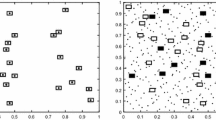Abstract
Cost-effective spatial sampling strategy requires balancing sampling costs with the expected benefits from improved information. A contaminated site numerical model was used to test various single-phase sampling schemes, which were evaluated based on the quality of block selections from interpolated values. Different sample set sizes, different sampling patterns, and two levels of sampling precision were used. The sample set size was the only one of these factors observed to be significant. Bias was also examined. Modest levels (<20%) had minimal impact; the effects of higher levels of bias varied with the selection level concentration.
Similar content being viewed by others
References
Barnes, R. J., 1989, A Partial History of Spatial Sampling Design: Geostatistics (Newsletter of the North American Council on Geostatistics), v. 3, n. 2, p. 10–13.
Burgess, T. M., Webster, R., and McBratney, A. B. 1981, Optimal Interpolation and Isarithmic Mapping of Soil Properties: IV. Sampling Strategy: J. Soil Sci., v. 32, n. 4.
Englund, E. J., 1990, A Variance of Geostatisticians: Math. Geol., v. 22, p. 417–456.
Englund, E. J., and Sparks, A. R., 1988, Geo-EAS (Geostatistical Environmental Assessment Software) User's Guide, EPA/600/4-88/033: U.S. EPA, Las Vegas, 174 p.
Isaaks, E. H., and Srivastava, R. M., 1989, An Introduction to Applied Geostatistics: Oxford University Press, New York, 561 p.
Journel, A. G., 1984, in G. Verly et al. (Eds.), Geostatistics for Natural Resources Characterization, Part I: D. Reidel Publishing Company, p. 261–270.
Olea, R. A., 1984, Systematic Sampling of Spatial Functions: Kansas Geological Survey, Lawrence, 50 p.
Switzer, P., 1979, Statistical Considerations in Network Design: Water Res. Res., v. 15, n. 6.
Yfantis, E. A., Flatman, G. T., and Behar, J. V., 1987, Efficiency of Kriging Estimates for Square, Triangular, and Hexagonal Grids: Math. Geol., v. 19, p. 183–205.
Author information
Authors and Affiliations
Additional information
Although the research described in this article has been supported by the United States Environmental Protection Agency through cooperative agreement CR814701 to the Environmental Research Center of the University of Nevada, Las Vegas, it has not been subjected to Agency review and, therefore, does not necessarily reflect the view of the Agency and no official endorsement should be inferred.
Rights and permissions
About this article
Cite this article
Englund, E., Weber, D. & Leviant, N. The effects of sampling design parameters on block selection. Math Geol 24, 329–343 (1992). https://doi.org/10.1007/BF00893753
Received:
Accepted:
Issue Date:
DOI: https://doi.org/10.1007/BF00893753




